The Samsung 750 EVO (120GB & 250GB) SSD Review: A Return To Planar NAND
by Billy Tallis on April 22, 2016 8:00 AM ESTATTO
ATTO's Disk Benchmark is a quick and easy freeware tool to measure drive performance across various transfer sizes.
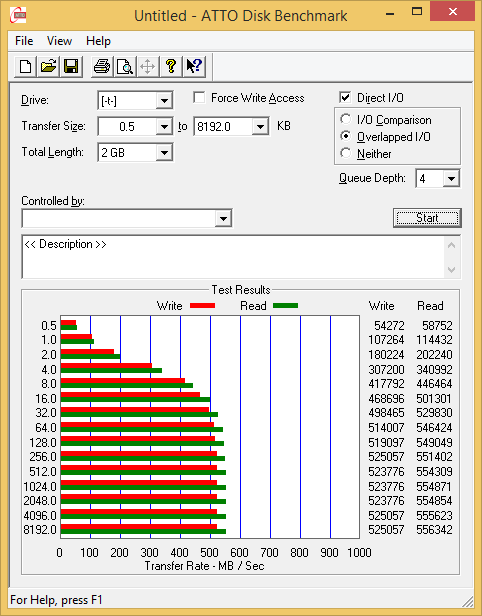 |
|||||||||
The ATTO benchmark shows the 750 EVO has good performance on small transfers and a maximum write speed that is very close to the read speed. The 120GB 750 EVO even provides better write speeds than the 850 Pro 128GB thanks to the former's SLC write caching.
AS-SSD
AS-SSD is another quick and free benchmark tool. It uses incompressible data for all of its tests, making it an easy way to keep an eye on which drives are relying on transparent data compression. The short duration of the test makes it a decent indicator of peak drive performance.
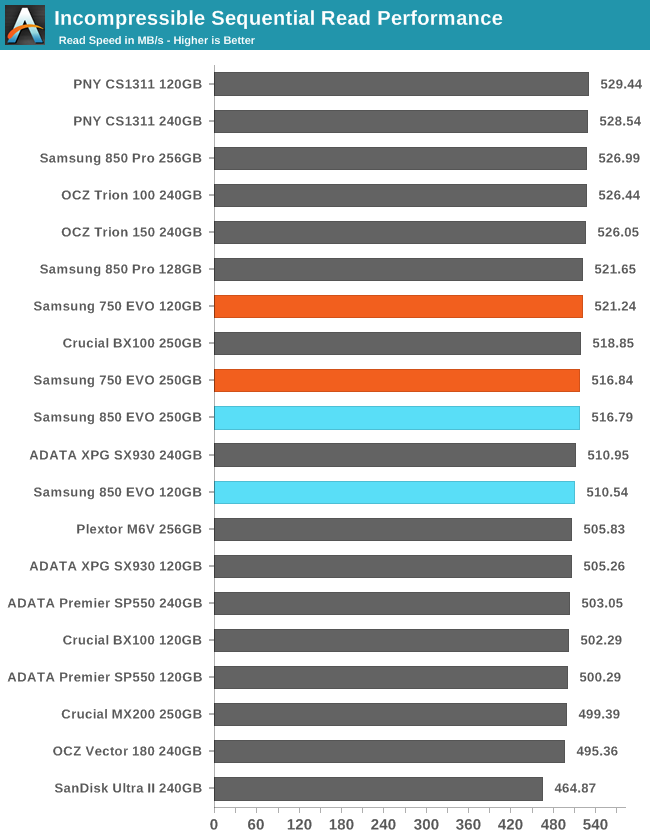
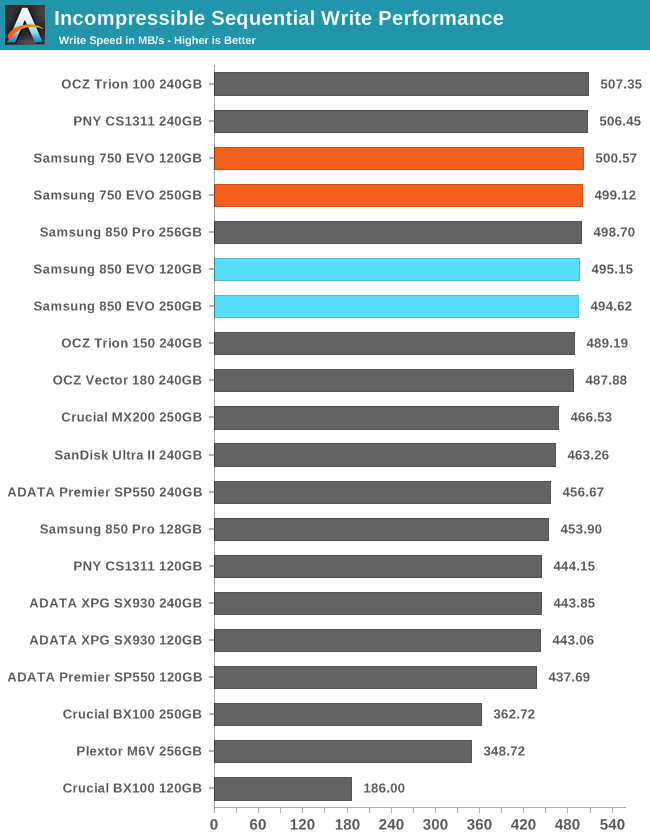
The 750 EVO provides top-notch burst speeds for reads and writes. The write speeds in particular distinguish the 750 EVO from most other TLC drives and low-end MLC drives that suffer from a lack of parallelism at small capacities.
Idle Power Consumption
Since the ATSB tests based on real-world usage cut idle times short to 25ms, their power consumption scores paint an inaccurate picture of the relative suitability of drives for mobile use. During real-world client use, a solid state drive will spend far more time idle than actively processing commands. Our testbed doesn't support the deepest DevSlp power saving mode that SATA drives can implement, but we can measure the power usage in the intermediate slumber state where both the host and device ends of the SATA link enter a low-power state and the drive is free to engage its internal power savings measures.
We also report the drive's idle power consumption while the SATA link is active and not in any power saving state. Drives are required to be able to wake from the slumber state in under 10 milliseconds, but that still leaves plenty of room for them to add latency to a burst of I/O. Because of this, many desktops default to either not using SATA Aggressive Link Power Management (ALPM) at all or to only enable it partially without making use of the device-initiated power management (DIPM) capability. Additionally, SATA Hot-Swap is incompatible with the use of DIPM, so our SSD testbed usually has DIPM turned off during performance testing.
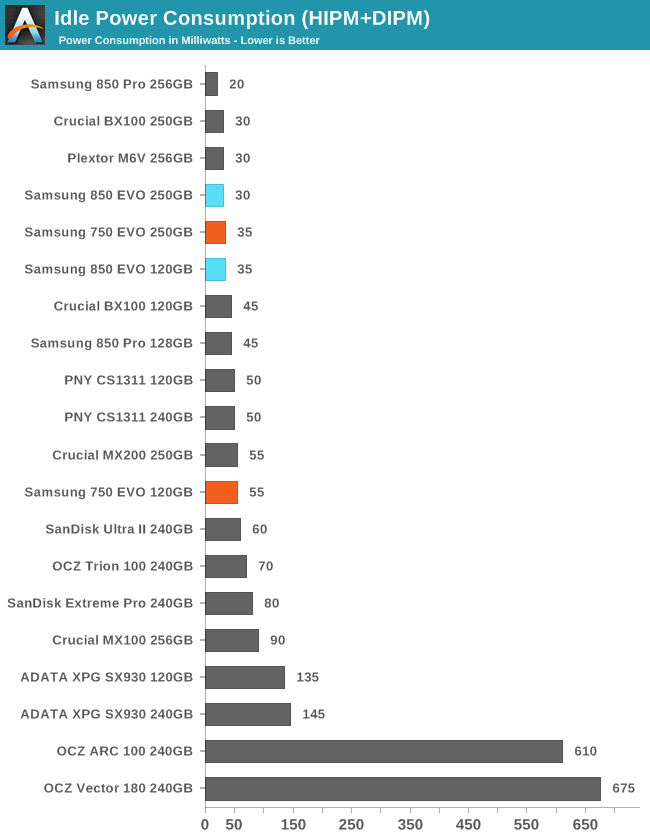
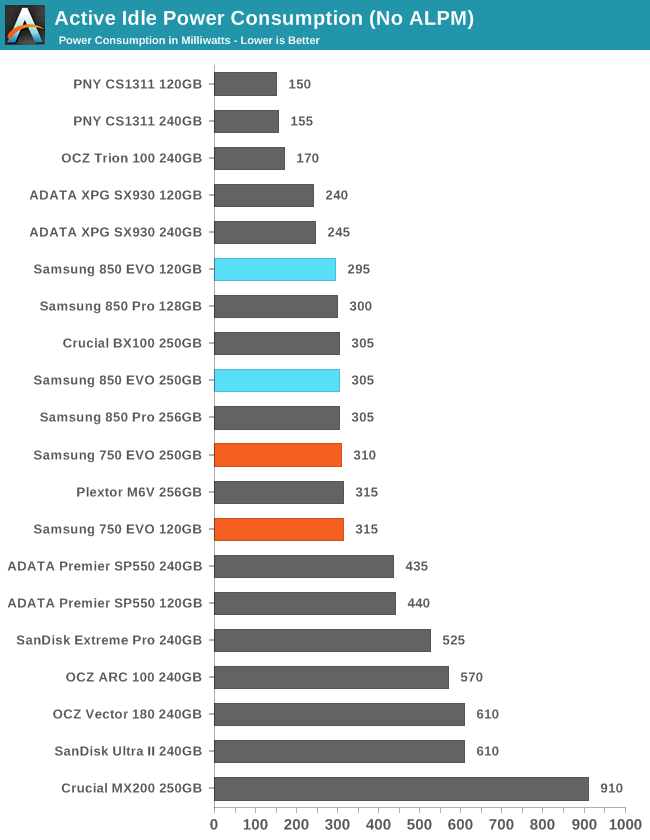
Idle power consumption of the 750 EVO is comparable to other Samsung drives: great when ALPM is enabled, and average when it is disabled.










109 Comments
View All Comments
BurntMyBacon - Monday, April 25, 2016 - link
@vladx: "Don't know what you mean, I also have a 840 EVO and can confirm the performances issues are gone after the 2nd fix."The fix forces a periodic rewrite of data that shouldn't have been necessary. Also, the fix doesn't work for machines that are powered down for large periods at a time as it requires power to monitor and execute the rewrites. This fix isn't optimal as it lowers the effective endurance of the drive. Combine that with the fact that the drive uses TLC flash with a write endurance of 1000x and you have a situation that enthusiasts aren't exactly "enthusiastic" to hear about.
That said, under normal consumer use, it will make little difference to the overall longevity of the computer. Use cases that are constantly modifying the whole data set will see little difference as the new firmware will not need to rewrite what is essentially fresh data. Use cases that see little writing will require the firmware to initiate rewrites, but they aren't consuming their write cycles at a very fast rate to begin with. However, use cases that constantly write and rewrite a small set of data while maintaining a large set of data that remains unmodified would result in a notably (though not excessively) lower life expectancy.
vladx - Monday, April 25, 2016 - link
"Also, the fix doesn't work for machines that are powered down for large periods at a time as it requires power to monitor and execute the rewrites."First, you shouldn't use an SSD for cold storage. Secondly, those periodic rewrites are insignificant to the life expectancy from user perspective, Just read the Techreport series on SSD endurance (http://techreport.com/review/26523/the-ssd-enduran... and you'll see that manufacturers are very conservative on the endurance numbers on consumer drives. They intentionally do it in order to not have consumer products take a piece of the enterprise pie.
And lastly, my point was the performance is back and like I mentioned without any real-world impact so stop spreading FUD like so many others on this site.
Alexvrb - Monday, April 25, 2016 - link
Yeah I've got at least one machine with an 840 Evo and it has been working great. 850 Evo is better, of course, I've got one of those too. I'd definitely trust one to at least not corrupt data over some of the other offerings (I'm looking at you, OCZ). Performance on my 850 Evo is hard to beat for the money, as well. This 750 Evo however, looks weak by comparison. They should sell it to OEMs cheap, and anyone in the retail market should shop around more.Oxford Guy - Monday, May 2, 2016 - link
There's a difference between a fix and a kludgy workaround.Ascaris - Tuesday, April 26, 2016 - link
Indeed. My Samsung 840 Pro 128GB in my main (desktop) PC has been in service for 2 years, four months, and has accumulated 32.55TB written. SMART indicates it still has 84% of its wear-leveling count remaining. That's another 11.8 years at this rate (and it will probably live well beyond its rated limit, if it is anything like the torture-tested 840 Pro as reported by TR). It would be near the end of its rated life if it were the 750 Evo.vladx - Tuesday, April 26, 2016 - link
@Ascaris: 84%? My 840 Evo is still 97% after 21 TB of written data so wear-leveling rating might not drop linearly.leexgx - Wednesday, April 27, 2016 - link
@vladxsmaller the SSD faster the health drops
bigger SSDs has more NAND space so they last longer the bigger the SSD is just companies tend to rate all there SSDs with the same say 50 to 150TB rated life/warranty void for all sizes but that is just for warranty that's all so they are not used in server type loads (most of them can do at least 500TB before they start to fail or show uncorrectable errors or high relocate sectors)
leexgx - Wednesday, April 27, 2016 - link
@Ascaristhe TR test on all them drives was interesting and the the 840 Pro drive can be used way past its rated life past 2PB of data can be possible it even was 0 error free even with the power failure up to the point it suddenly failed with no warning which probably was a full NAND chip fail (as that site that was trashing them with random write to a bunch of SSDs so the drive might of had more writes if its was sequential writes, the test would of concluded a lot sooner if sequential writes was used)
haukionkannel - Friday, April 22, 2016 - link
If you sell 10000 computers, that 10$ will make 100000$ Profit. And 10000 computers is a very small Number... 20 cent is big money to production cost. Do you ever wonder why Intel use very crap thermal paste in their consumer prosessors? It is 1 cent cheaper or even more than better stuff, and Also goes old soon enough after the warranty goes old...They Are making Profit, not making the best bang for the back to the customers...
JimmiG - Monday, April 25, 2016 - link
Yeah, that's why this drive is primarily aimed at system builders. If you're buying a 120 or 250GB drive for your own system, it's silly to not pay $10 more for the 850 Evo.